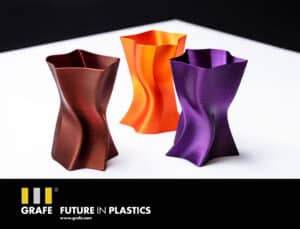GRAFE develops varied silk gloss effect

With a broad spectrum of infinite color variations, GRAFE, Blankenhain, is bringing variety to the market for 3D printing applications and presenting this to its customers with a box at K 2022. This contains ten basic colors, of which a white polymer blend acts as a carrier. “The silk effect or gloss only really becomes visible in 3D printing,” explains Lars Schulze, Head of Color Development and Material Sciences. “With the colors, we offer a tested base, the so-called silk effect with corresponding good printability and high gloss level.” The project was specifically developed to reproduce this noble gloss effect. Certain pigments’ selection avoids matting, leading to the highest gloss level.
Two color combinations in a shapely vase look provide a preview for design inspiration. The two color models are presented in a high-quality box. A color table with 19 mixing examples (UPDATE 11/10/2023: 24 mixing examples) is intended to serve as a stimulus among the infinite color combination possibilities and to represent the most diverse demands of users. It serves as an orientation and should make it possible to meet customer requirements quickly. In addition, the customer receives corresponding dosing suggestions. However, the presentation samples only provide inspiration for users because there are no limits to color fantasy with the basic colors, and the user can mix his colors creatively and achieve individual color shades.
“We give our customers the opportunity to become imaginative themselves. Up to now, there has only been a small choice of colors for high-gloss filaments on the 3D printing market. We want to change that with our expertise in coloring plastics and offer a basis for customization with our masterbatch,” explains Schulze. GRAFE has its own filament extruder and 3D printer in-house and can thus produce and test appropriate filaments itself. “In this way, we are able to try out our own developments. This significantly reduces development times, as the time-consuming testing process at the customer’s premises is no longer necessary,” says Schulze.
